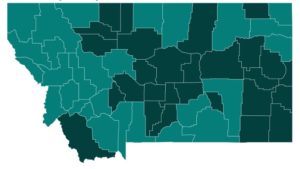Commercial Building Owners, Interested in Jumping into Recreational/Adult-Use Marijuana?
There’s no doubt that some Montana CRE owners see the potential for recreational marijuana (AKA “adult-use” marijuana). Read on for a breakdown of the CRE considerations within the laws in place governing how the industry.
In many Montana cities counties, work on adult-use recreational marijuana policies is underway. Montanans voted to legalize the adult use of marijuana in November 2020 and – after some hemming and hawing at the state level regarding the regulation of the formerly controlled substance – cities are now forging ahead to shape municipal policy for marijuana use.
What does this mean for the commercial real estate sector? Because regulations vary by county, ownership should carefully consider partnerships with adult-use marijuana growers, manufacturers, retailers, and testing facilities.
Where is it Legal in Montana?
First, state law only allows for adult-use marijuana industries in the counties where more than 50% of voters approved the measure.
Adult-use or recreational marijuana is legal in the following Montana counties.
Big Horn, Blaine, Carbon, Cascade, Deer Lodge, Flathead, Gallatin, Glacier, Granite, Hill, Jefferson, Lake, Lewis and Clark, Lincoln, Madison, Mineral, Missoula, Park, Powell, Ravalli, Richland, Roosevelt, Rosebud, Sanders, Sheridan, Silver Bow.
That means there’s no current legal adult-use marijuana industry in these Montana counties.
Beaverhead, Broadwater, Meagher, Pondera, Teton, Toole, Stillwater, Sweet Grass, Wheatland, Liberty, Chouteau, Judith Basin, Fergus, Golden Valley, Musselshell, Petroleum, Phillips, Treasure, Garfield, Daniels, McCone, Dawson, Prairie, Custer, Powder River, Wibaux, Fallon, Yellowstone, and Carter counties. (Though the law also states that none of these counties may prohibit the transport of licensed adult-use marijuana through their jurisdictions). Note that Billings, in Yellowstone County, is likely to vote on adult-use marijuana in city limits soon.
However, local governments can hold separate votes to approve adult-use marijuana businesses. But it’s unclear how likely that it is, given that these counties already expressed their opinion at the ballot box. Investors looking to jump into the industry should consider exploring opportunities in the counties that approved the measure in 2020.
It’s also worth noting that some cities and counties on the edge of more conservative rural areas might experience additional regulation.
In Great Falls, some members of the public have called for more restrictive local policy than what is found in the state legislation – in one case, asking the Cascade County commissioners to double the established buffers between marijuana businesses and schools.
In Billings, only four total adult-use stores will be allowable (should a vote to approve adult-use marijuana pass at all).
Kalispell has already placed strict limits on medical marijuana, which may likely bleed into adult-use regulation. One mayoral candidate in Kalispell said, “In effect, what we’ve done is we’ve banned this new cannabis industry from Kalispell.”
However, cities like Missoula see less public outcry.
Where does the tax revenue from adult-use marijuana go? $6 million per year for addiction treatment services; 20% of revenues to conservation; 4% of revenues, up to $650,000 each, to state parks, trails, recreational facilities, and wildlife protection; $200,000 to veterans services and improving veterans’ cemeteries; $300,000 to the purchase of drug detection dogs; $150,000 for police training; and remaining amount to the state’s general fund
License Types and CRE Considerations
There are a couple of unifying factors across all adult-use license types. First, no marijuana products may be consumed on the premises where they are cultivated, manufactured, tested, transported or sold. Secondly, adult-use marijuana facilities of any kind may not engage in hemp-related activities.
Beyond these regulations, each type of license comes with specific considerations for landlords, investors, and building owners who may want to dip a toe into the adult-use marijuana industry.
For retailers and/or retail building owners:
Montana state law dictates that the shop must have one single-secured customer entry/exit, must maintain a 500-foot buffer away from schools and places of worship, and must also maintain the 500-foot buffer away from other dispensaries (both medical and adult-use).
Another key consideration for retailers is visible products and/or advertising. The law prohibits any visible marketing or advertising of dispensary products. That means retail operations cannot allow the products inside their stores to be seen by someone passing by. That leads to things like updated facades sans windows or frosted, painted, or otherwise covered storefronts. Leasing space to retailers should include a conversation about their plans to align with Montana state law if there is visibility into the store from public areas like the street or sidewalk.
For industrial building owners:
Finding a knowledgeable broker is key to a smooth transition to the adult-use marijuana industry. It’s especially important to be sure your building is zoned correctly for the user, whether that be manufacturing, commercial cultivation, testing, or distribution. Your broker can help parse through state law, as well as local zoning and land use guidelines.
State law requires that manufacturing activities must not be visible from public areas nearby and that no portion of the property can be leased or shared with another marijuana business. Energy use might be one concern, with research by Missoula planners showing that cultivation facilities can use 7-8 times more energy.
Cultivation activities have similarly rigorous rules. Cultivators must have acquired their license for outdoor growing prior to November 3, 2020 – and they’ll likely need fencing or other blocking materials so any outdoor growing activities aren’t visible from the street.
Tier System
What tier of license does the cultivator have – and why does it matter? The tiered system sets up a general timeline for expanding an adult-use cultivation operation. Each tier has an associated cost, which may be a barrier to entry (or expansion) for some potential cultivators. Operators may only advance through one tier at a time after June 2023.
Per Montana Code Annotated, here’s what each license tier allows for in terms of “canopy.” (Canopy means “the total amount of square footage dedicated to live plant production at licensed premises consisting of the area of the floor, platform, or means of support or suspension of the plant.”) We added the licensing and annual costs for each tier in brackets.
Tiers:
- (i) Micro tier. Up to 250 square feet at one indoor cultivation facility. [$1000]
- (ii) Tier 1: Up to 1,000 square feet at one indoor cultivation facility. [$2500]
- (iii) Tier 2: Up to 2,500 square feet at up to two indoor cultivation facilities. [$5000]
- (iv) Tier 3: Up to 5,000 square feet at up to three indoor cultivation facilities. [$7500]
- (v) Tier 4: Up to 7,500 square feet at up to four indoor cultivation facilities. [$10,000]
- (vi) Tier 5: Up to 10,000 square feet at up to five indoor cultivation facilities. [$13,000]
- (vii) Tier 6: Up to 13,000 square feet at up to five indoor cultivation facilities. [$15,000]
- (viii) Tier 7: Up to 15,000 square feet at up to five indoor cultivation facilities. [$17,500]
- (ix) Tier 8: Up to 17,500 square feet at up to five indoor cultivation facilities. [$20,000]
- (x) Tier 9: Up to 20,000 square feet at up to six indoor cultivation facilities. [$23,000]
- (xi) Tier 10: Up to 30,000 square feet at up to seven indoor cultivation facilities. [$27,000]
- (xii) Tier 11: Up to 40,000 square feet at up to eight indoor cultivation facilities. [$32,000]
- (xiii) Tier 12: Up to 50,000 square feet at up to nine indoor cultivation facilities. [$37,000]
Existing Providers Take the Lead – But Not Without Hurdles
The state law gives preferential treatment to existing Montana medical marijuana providers. These providers may apply for adult-use licenses beginning January 1, 2022. Everyone else must wait until July 1, 2023 to apply for an adult-use marijuana business license.
But, existing providers caution that supply may be constrained in the early months of formal legalization. Some current medical marijuana operators have shared concerns that Montana’s rising tourism numbers, alongside local users, will scoop up new products as soon as they hit the shelves.
Industrial Buildings in Demand for Recreational Marijuana
A lack of industrial buildings with appropriate zoning could also hamstring local providers; in some larger Montana cities, industrial vacancy is dropping quickly. Demand for industrial space is heating up, and not just for adult-use marijuana growing and manufacturing operations.
As the last mile network expanded during the pandemic, much of the existing infrastructure was put into use for distribution. Then, as material shortages occurred, some companies were forced to store product as the supply chain short-circuited. A builder might have to store finish materials while they waited for structural components to arrive at a job site. Altogether, this led to a crunch in the industrial sector that may impact adult-use marijuana.
Contact Connor McMahon for more info on retail opportunities in Montana. For industrial options, contact Claire Matten.





